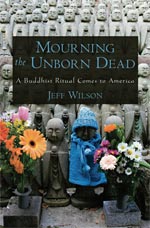
EVEN WOMEN who are determinedly pro-choice seldom experience abortion without some shame or remorse. And miscarriage is a loss many never get over. Buddhist rituals don’t always translate to Western practice, but in Mourning the Unborn Dead: A Buddhist Ritual Comes to America (Oxford University Press, 2009, $35.00 cloth), Tricycle contributing editor Jeff Wilson examines the gradual infiltration of one very special ceremony, the mizuko kuyo, which honors aborted, miscarried, and stillborn fetuses. Originating in Japan, where abortion is common and widely accepted, the ritual centers on Jizo, the bodhisattva who vows to save all beings from the hell realms and is
seen as the protector of the unborn.
According to Wilson, assistant professor of religious studies and East Asian Studies at the University of Waterloo, in Canada, the Jizo ritual has been quietly gaining popularity in the West over the past 40 years, among non-Buddhists and Buddhists alike. While in Japan the emphasis is on placating angry spirits—and preventing the unborn fetus’s unfavorable rebirth—here the purpose is largely to find solace in the face of grief over pregnancy loss.
Little has been written about the ceremony in the West, apart from Jizo Bodhisattva, published in 2001 by Zen teacher Jan Chozen Bays, one of the first to perform it for Americans. Wilson’s more scholarly approach traces the mizuko kuyo as it moved out of the Japanese-American community to convert Buddhists and even to prolifers, providing a vehicle for healing at a time when abortion has come under increasing fire from religious conservatives. Although Wilson explores the many forms the ritual takes, this is not a how-to manual for designing your own. Rather, he offers a far-reaching and sympathetic look at a growing movement, reassuring us in graceful language that “the softly smiling Jizo…may yet hide deeper surprises for those who come to [him] for aid.”